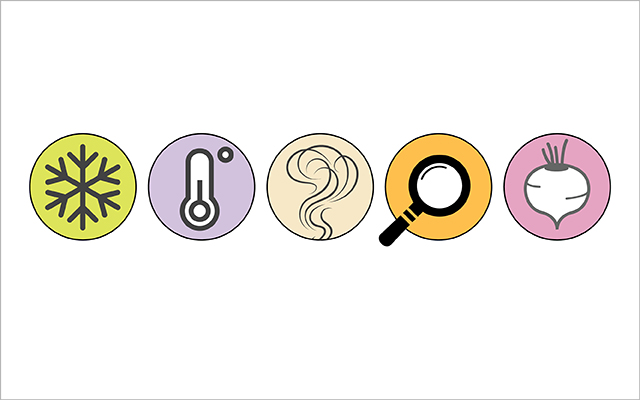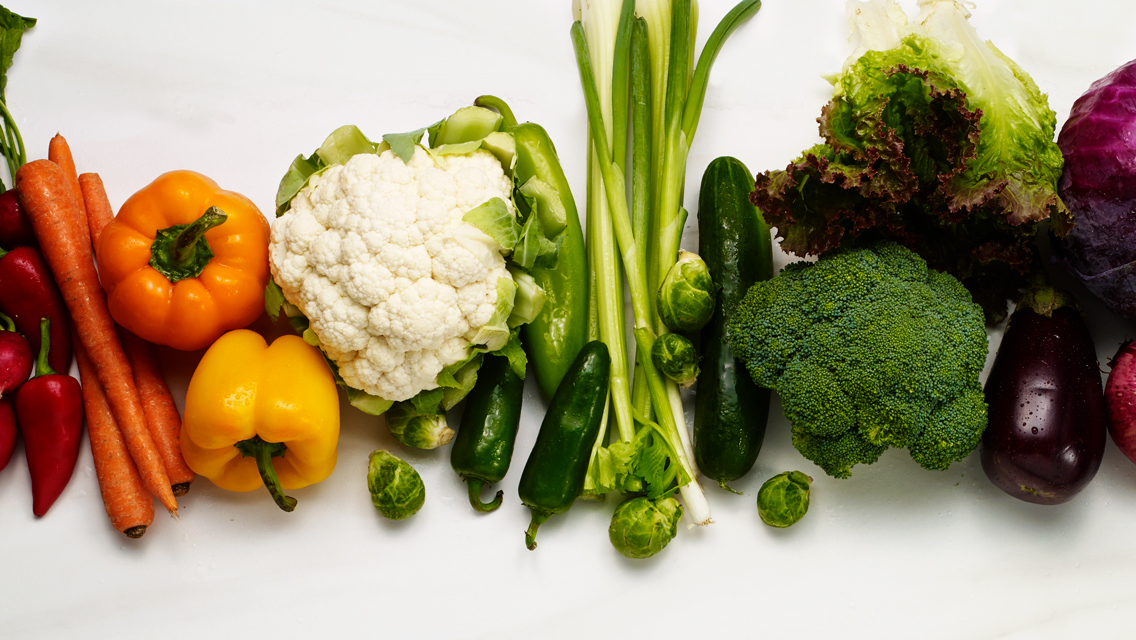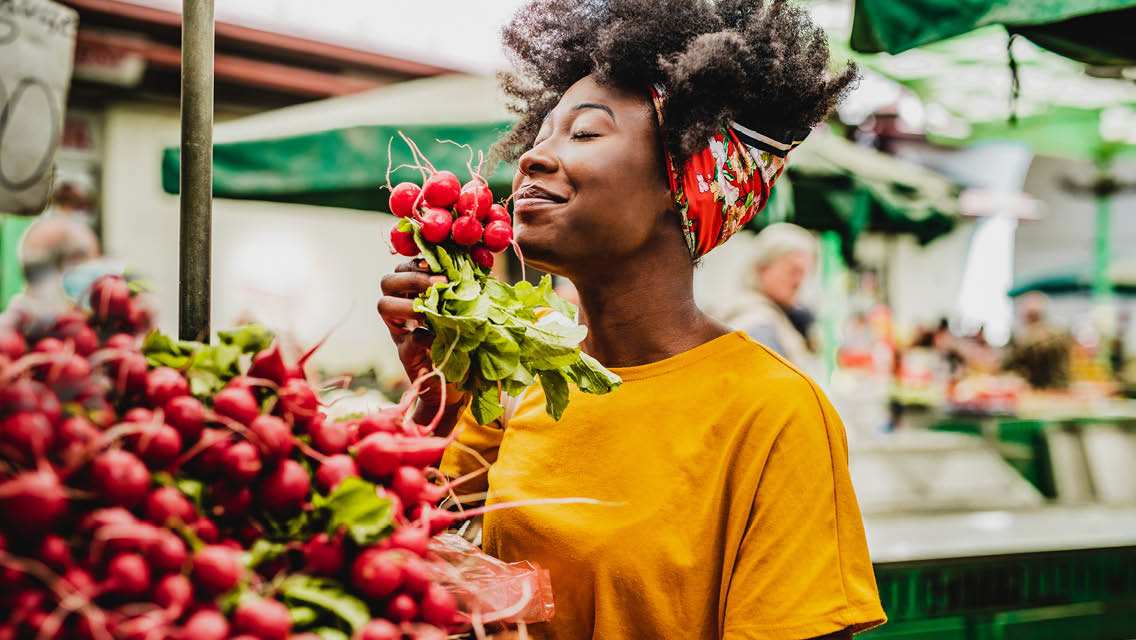There’s nothing quite like the lure of a well-stocked produce aisle. The kaleidoscope of colors and smorgasbord of scents is enough to make your mouth water. And just think — those luscious red strawberries, juicy peaches, crunchy carrots and plump peppers are simply brimming with healthy nutrients, right? Maybe, maybe not.
The answer may depend, in part, on how all that produce has been treated since it was picked and packed. While soil fertility, temperature, moisture level and other variables in the cultivation of produce can make a world of difference in the end product’s nutritional value, so do handling procedures after harvest.
A lot can happen from the time produce is plucked off the vine or pulled from the earth and when it arrives at the grocery store. And handling concerns don’t end once you bring your food home, either. Do you know which commodities should be stored in the fridge and which ones can actually lose nutrients if they’re chilled? Here, we follow the path of fresh produce, from the field to your kitchen, and highlight the handling practices that can make or break nutritional value.
From Harvest to Market
Shelf life actually begins at harvest, and from that point onward, the nutritional value of produce cannot be improved, only maintained or degraded. According to Adel Kader, PhD, postharvest physiology professor at the University of California, Davis, and internationally recognized expert in the care of fresh produce, the speed and timing of each stage of the postharvest process is critical to its nutritional value.
To begin with, whether harvested by hand or by high-tech machinery, she says, fruits and vegetables should be picked in the early morning, when temperatures are cool, and then moved as quickly as possible to a climate-controlled area. “Some products are harvested, sorted and packed directly in the field,” explains Kader, “while others are delivered directly to a packing house.” The method of packing depends on several factors, such as how much cleaning needs to be performed, whether or not the produce is to be waxed and whether or not sizing is critical in determining price.
“Those products that require more attention in all these areas, such as apples, pears, peaches and nectarines, will be sent to a packing house, whereas food like broccoli, cabbage, cauliflower, lettuce and strawberries are packaged right in the field by workers on mobile packing units,” he says.
Once produce is ready for shipment, it’s cooled and then transported under refrigerated conditions in trucks, airplanes or marine containers to distribution centers or wholesale markets.
Even a slight change in temperature during transport can have a big impact. A 1995 report by North Carolina State University’s Department of Horticultural Science found that for each 18-degree Fahrenheit increase above the optimum temperature for any given fruit or vegetable, the rate of its deterioration doubles or triples. And what’s considered optimum is not the same for all produce. For instance, cabbage is happiest at 32 degrees F., whereas sweet potatoes like a considerably warmer 55 degrees.
The duration of the harvest-to-market process depends on the distance produce has to travel. “Within the contiguous 48 states, the time period is two to seven days,” Kader says. If products are grown in California and sold in California, for example, it may only be a day or two. But, she notes, if products are grown in California and sold in New York, “you’re looking at more like six or seven days.” And when produce is out of season and must be imported from countries like Chile, Peru or New Zealand, the process may take anywhere from 10 to 30 days.
Kader and other experts agree that quick delivery time and proper temperature control are the most important handling factors when it comes to maintaining freshness and postharvest nutritional quality of both conventional and organic crops. Other issues include controlling humidity, maintaining sanitary conditions, and minimizing physical damage such as cuts, scrapes and bruises.
Rough handling anywhere along the line can take a devastating toll. Consider this from a 1998 study published in the Journal of the American Society for Horticultural Science: Bruising a tomato by dropping it from a distance of about 16 inches results in losses of 37 percent of carotenoids and 15 percent of vitamin C.
At the Market
Dean Goodale, an organic greenhouse grower with the Maharishi Vedic City Organic Farm in Iowa, says one of the best ways to ensure your produce is fresh and gently handled is to buy from local farms.
“At Maharishi we ship primarily to markets within 250 miles, so we can harvest and deliver the same day,” he says. Obviously, that reduces the risk of produce being mishandled or neglected.
If mass-market stores are your only option, you need to be more selective in order to choose the freshest, most nutritious items. Let your eyes be your guide. “Fresh produce looks vibrant,” says Christine Filardo, MS, RD, director of public relations at the Pro-duce for Better Health Foundation. “It’s not bruised, cut, shriveled, wilted or moldy.” All of these are signs that food has been mishandled or has simply sat too long, she says, and as a result, nutritional quality will definitely be affected.
Research confirms Filardo’s assertion. Remember the loss of carotenoids and vitamin C in bruised tomatoes? Most other produce suffers similar losses as it loses its visible luster. Research published in the Journal of Food Science in 1999 shows that as the appearance of lettuce degrades, the total ascorbic acid (vitamin C) content decreases.
Generally speaking, healthy produce looks the part. Yet even good-looking fruit and vegetables can be deceiving. There is really no way to accurately determine how far your produce has traveled, and under what conditions, by appearance alone. Some fruit and vegetables have stickers proclaiming where they originated: Chile limes, Washington apples, Florida avocados. But that doesn’t tell you much about their journey to the store.
Your best bet: Simply ask the produce manager. He or she should be able to tell you some history about the store’s produce. Also, most retail grocery produce is sold within two to three days on average, according to Kader. So if you want the freshest choices, find out when your grocery store stocks new shipments and try to shop on those days. (Want the freshest produce in the store? Learn what to look for and select the freshest options with these tips.)
At Home
Unlike prepackaged fruits and vegetables, whole produce doesn’t come with expiration dates, so once you get it home, your job is to keep it as fresh as possible. Aside from appearance, the best way to judge freshness is through taste. “There’s a difference between taste life span and appearance life span for fresh produce,” he says. “They’re both important, but taste life span is only about two-thirds that of appearance, and when taste goes, so do nutrients.”
You may not have the option of taste-testing fruits and veggies at the market, but you can certainly do it at home. Let your eyes, nose and taste buds guide you; they’ll quickly tell you when produce is past its nutritional prime.
Storing:
Fruits and vegetables continue to breathe even after harvest. This causes them to lose moisture and ultimately reduces nutrients and shelf life. Respiration rates differ across varieties, and storage guidelines regarding optimal temperature and wrapping are aimed at slowing this process and retaining moisture.
Ideally you’d eat whatever you buy within a few days, but since that’s not always possible, what is the optimum way to store fruits and vegetables? In the fridge? In the pantry? On the counter? Depending on the produce, it may be a combination of all three (see “Putting Produce in Its Place,” below, for specifics).
You may have heard it’s wise to store certain produce items in isolation from others. The reason for this, according to Kader, concerns ethylene, a gas released by certain produce such as tomatoes, apples, apricots, nectarines, peaches and pears. “Ethylene is a good thing if you want to speed up ripening, but it can also significantly reduce the shelf life of other commodities exposed to it,” he says. “More fruits than vegetables release ethylene, so the easiest thing to do is put your fruits in one container and vegetables in another.” And if you notice any damaged or overripe produce, toss it out: Its strong ethylene output will cause rapid spoiling of nearby foods.
Kader also recommends wrapping produce in perforated plastic bags to retain moisture. Perforations are required to prevent fermentation, so simply poke holes in zippered bags (around 20 for a medium-size bag). There’s no need to perforate the thin plastic bags offered in your grocery store’s produce section.
Washing:
To wash off dirt and chemical residues picked up during shipping and handling, the only cleaning agent you really need is fresh, cool water, according to Filardo. “Growing-and-packaging standards are governed in such a way that whether you’re buying produce from a national grocery-store chain or a small local farmers’ market, any pesticide residue or other sanitizing concern is so minimal that it will be addressed by simply rinsing the produce in cool water and gently using a vegetable brush,” she says.
Still don’t feel that your produce is clean enough? You might be tempted to reach for something more potent, but Keith R. Schneider, assistant professor of food science at the University of Florida, says you should never use household detergent, bleach, hand soap or dishwashing liquid to wash your fruits and vegetables, as some produce is porous and can absorb the cleaning agent. He instead suggests using a food-grade cleaner like vinegar. Just soak the produce in equal parts vinegar and warm water for a few minutes, then rinse.
Fruit and vegetable washes may be convenient, but they have not stood up to scientific scrutiny. A recent study by University of California, Riverside researchers, published in the Bulletin of Environmental Contamination and Toxicology, concluded that Fit Fruit and Vegetable Wash was no more successful than water at removing surface residue. Also, experts at the University of Maine found that soaking blueberries in distilled water for one to two minutes was just as effective at removing microbes — and in two instances more effective — as compared with three commercial wash treatments.
Finally, wash fruits and vegetables right before eating. If you wash them prior to storage, they will spoil more quickly. (An exception is lettuce, which can be rinsed before refrigerating to help maintain crispness.) It’s even a good idea to wash peelable fruits (such as oranges, bananas and melons) before eating; otherwise you risk spreading dirt and germs from the outside to the edible portion of the fruit during handling.
Cooking:
By this point, you and your produce have come a long way. It would be a shame to needlessly sacrifice nutrients during preparation and cooking. Filardo says you’ll retain the most nutrients by eating most fruits and veggies raw, but adds that cooking often improves the flavor of produce, thereby increasing the likelihood you’ll eat more. Plus, some people find lightly cooked vegetables easier to digest — an important factor in nutritional assimilation.
The general rule of thumb is to “cook produce as quickly as possible, using the least amount of water and the lowest possible temperature,” Filardo says. The two techniques she recommends for locking in maximum nutrition are steaming and quick stir-frying.
Research from 2003 in the Journal of the Science of Food and Agriculture reported that steaming resulted in the least amount of antioxidant loss (up to 11 percent). Boiling was considerably worse at 66 percent, and microwaving on full power for five minutes with 2⁄3 cup of water wiped out 74 to 97 percent of three different types of antioxidants.
If you must microwave, Filardo suggests, keep cooking time to a bare minimum and use only enough water to create steam. “One to two tablespoons of water should be plenty,” she says.
Even something simple like slicing can reduce nutritional quality. In the Journal of Food Science, investigators reported that lettuce retained more vitamin C when torn by hand than when sliced with a knife. Manual slicing reduced vitamin C by 18 percent over tearing, and machine-sliced lettuce suffered an even greater loss of 25 to 63 percent more than tearing.
Who knew fresh produce needed so much TLC? But if you’re kind to your fruits and vegetables, the nutritional payoff will be well worth it.
Putting Produce in Its Place
Store at room temperature:
Fruits and Melons
-
- apples (no more than 7 days), bananas, grapefruit, lemons, limes, mandarins, mangoes, muskmelons, oranges, papayas, persimmons, pineapples, plantain, pomegranates, watermelons
Vegetables
-
- basil (in water), cucumbers +, dry onions *, eggplant +, garlic *, ginger, jicama, peppers +, potatoes, pumpkins, winter squash, sweet potatoes *, tomatoes *
Ripen on the counter first, then store in refrigerator:
Fruits and Melons
Store in refrigerator:
Fruits and Melons
-
- apples (more than 7 days), apricots, blackberries, blueberries, cherries, cut fruit, figs, grapes, raspberries, strawberries, nashi (Asian pears)
Vegetables
-
- artichokes, asparagus, green beans, lima beans, beets, Belgian endive, broccoli, Brussels sprouts, cabbage, carrots, cauliflower, celery, cut vegetables, green onions, herbs (not basil), leafy vegetables, leeks, lettuce, mushrooms, peas, radishes, spinach, sprouts, summer squash, sweet corn
* Store in a well-ventilated area in the pantry. Protect potatoes from light to avoid greening.
+ Can be kept in the refrigerator for one to three days, if used soon after removal.
Reproduced from Storing Fresh Fruits and Vegetables for Better Taste by Adel Kader, PhD, Jim Thompson, PhD, and Kathi Sylva, PhD, University of California, Davis, Postharvest Technology Research and Information Center, 2000. Printed with permission of Adel Kader, PhD.
This article has been updated and originally appeared as “Handle With Care” in the May 2005 issue of Experience Life.




This Post Has 0 Comments